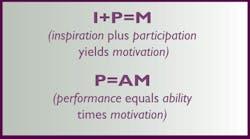Some basic management tactics can address poor safety performance, but true safety excellence requires strategy. Effective safety strategy should be based on an understanding of the formulas for human performance. But, before discussing the formulas and skills needed for excellence, let's define excellence.
Excellence is not just a momentary peak in performance, but the ability to duplicate that peak year after year. It is not accidental nor is it mystical. It is the application and continuous improvement of a safety strategy that achieves and measures its own progress. Ironically, most organizations don't really have a safety strategy that directs and unites the various safety efforts into a coherent whole. Even fewer organizations effectively measure their safety performance in a way that allows for deep understanding of what is working and the ability to duplicate it in the future. Safety excellence at the organizational level requires safety excellence at the individual level. Leaders must understand the basic formulas for performance if they are to accomplish this lofty goal.
The first formula for safety excellence is P=AM (performance equals ability times motivation). Many leaders expend the majority of their resources to increase the ability of their work force, rather than the motivation. They may be focusing on an element of performance that already is good and difficult to improve, and ignoring an element that is weak and easily improved.
You don't lead an organization to safety excellence simply by being an excellent leader; you do so by leading excellent people! You lead people to excellence by helping them improve both their ability and their motivation. People of mediocre skills need to improve their abilities. People of great ability need to be motivated. Most safety leaders don't realize or act on this important difference.
Employee Involvement
It has been argued that workers don't need to be motivated to be safe; they are the ones who get injured if they are not safe and have a vested interest in their own safety. This is true, but overall organizational excellence is not just about everyone looking out for him or herself; it is about everyone looking out for everyone else as well. You don't have to be motivated to look out for your own self-interest, but if the organization wants its people to go well above and beyond self-interest, they should motivate them to do so.
The next formula is I+P=M (inspiration plus participation yields motivation).This kind of motivation is not accomplished by the old carrot-and-stick methods of the past. It is accomplished by involving everyone in the rationale and benefits of safety excellence. It must answer the “what's-in-it-for-me” (WIIFM) question in a way that inspires employees. This is motivation through a team-building exercise in which everyone is expected to go above and beyond his or her own self-interests. This is motivation based on a deep caring for both the team and the organization. Such motivation is based on the pride of winning the war against accidents and celebrating the victory. The two greatest human needs are affinity and affiliation (the need to believe in something and the need to belong to something), and safety excellence can be a meaningful part of fulfilling these two basic needs.
Inspiration should be followed by participation. Deming noted that people support what they help create. Few workers have a significant part in creating their own safety programs. Most leaders express a desire for workers to be more participative, but few design such opportunities into their safety processes. Leaders also may not realize that participation is a form of delegation. If the leader does everything, what is left for the worker to do? Allowing workers to be involved and help create safety programs can feel like letting go of control to many leaders, which is uncomfortable to some and completely unacceptable to others. However, it is a necessary skill for leading excellence.
Delegating & Coaching
The two key skills of leadership are delegating and coaching (leadership equals delegating plus coaching). Leaders who fail to develop the talents of their team or hand off work will stifle the growth of their organizations.
Coaching is the ability to help improve the performance of another person. True leaders constantly strive to improve the people they lead because they realize that leaders are evaluated as much by their teams as they are by their own performance. Organizational growth directly is dependent on the growth of each member of the organization. As individuals perform better, the collective performance of the organization will improve.
Delegating is how leaders create momentum and establish accountability. It also is how they multiply their own ability to get things done. If the leaders could do everything themselves, the followers would be unnecessary. Only through delegation can leaders move up the organizational pyramid and do more strategic work.
Safety should be a strategic part of organizational excellence. Leading individuals by developing their abilities and motivation is the key skill required to achieve excellence. Following such development with delegation and trust is the next step toward the goal. Leaders need to realize the critical importance of these steps and learn to let go of control as others in their organization grow into leadership roles. As organizations become capable of excellent safety performance without the constant intervention and direction of leaders, the long-term sustainability of excellence takes root.

